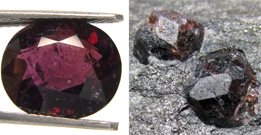 Photo of Almandine in Processed & Rough Form
Photo of Almandine in Processed & Rough Form
Almandine is a mineral with a hardness of 8 out of 10 on the Mohs scale of mineral hardness [?]. These Cubicly structured gems are made of iron aluminum silicate, their full chemical compound being Fe3Al2(SiO4)3.
Almandine or Almandite is a member of the Garnet group, and is associated with the planet Pluto. Low quality pyrope is often cataloged and sold as Almandine. Almandine is generally darker than pyrope.
Almandine colors vary from red to dark red, purple to purplish red, and even pink.
Almandine is valued fairly low at somewhere between $5 and $225 a carat all dependent upon clarity, color, cut, and lack of inclusions.
Despite its lack of popularity Almandine in great condition and cut correctly is a very beautiful stone.
Why do some Almandines appear black?
High iron content can make almandine appear very dark or almost black, especially in larger stones. The best specimens show deep red color when held to strong light. Proper cutting is crucial to prevent stones from appearing too dark.
What makes Star Almandine so special?
Star almandine showing asterism is extremely rare. The six-rayed star effect comes from rutile needle inclusions. These specimens are highly valued, especially when showing both sharp stars and good transparency.
How is Almandine different from Pyrope?
While both are red garnets, almandine typically shows darker, more violet-red tones due to iron content, while pyrope shows purer red. Many red garnets are actually mixtures of both (pyrope-almandine series).
Are Indian Almandines still considered best?
Historic Indian almandines, particularly from Rajasthan, set quality standards. However, fine specimens now come from many locations. Sri Lankan material is noted for exceptional clarity and lighter red colors.
Why do some show color change?
Rare almandine-pyrope intermediates can show subtle color change from red to purple. This phenomenon is different from the more dramatic change seen in other garnets and requires specific chemical composition.
Are Almandine gemstones ever treated?
Unlike many gemstones, almandine is rarely treated. Its color is natural and stable. Most commercial stones are completely natural, though some may be heated to improve clarity.
What's special about Finnish Almandine?
Finnish almandine crystals are prized for their exceptional crystal form and size. While not always gem quality, these specimens are highly valued by collectors for their perfect dodecahedral shapes.
The specific gravity [?] for Almandine is 4, its refractive index [?] is 1.76-1.83, and its double refraction [?] is None.
History
Almandine was very popular in the 19th century.
Noah (from the Hebrew Bible) used Garnet to light the Ark. It is also used in stained glass windows of churches around the world.
Industrial Usages
Garnets in general are good abrasives for sand blasting, and cutting of steel via pressurized water jets. Fine powdered versions of garnet can be found along shorelines in large quantities.







